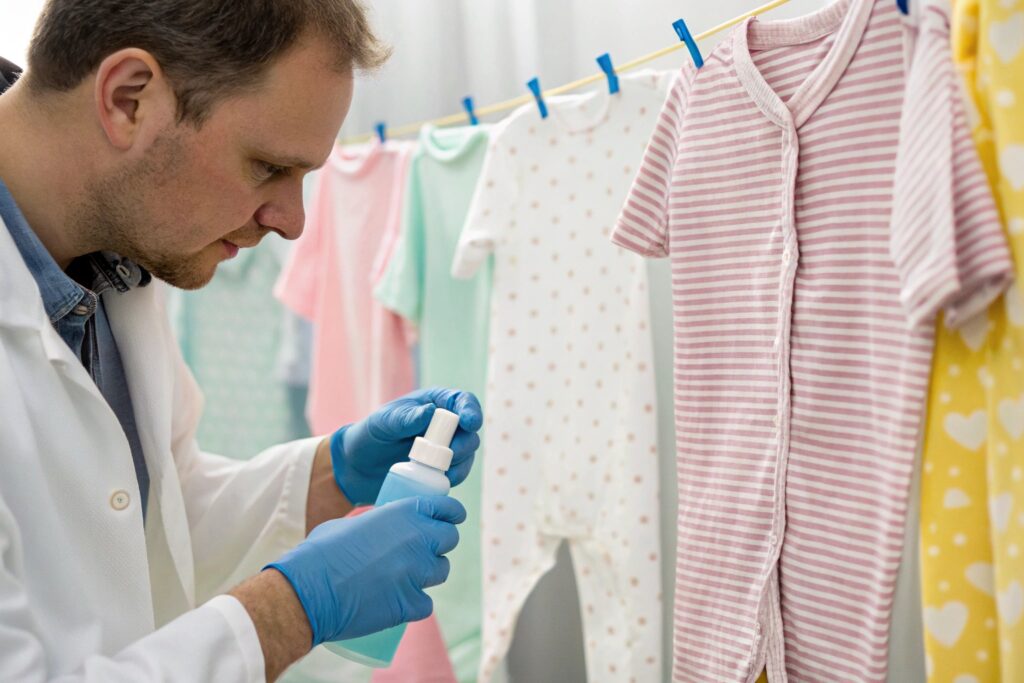In babywear, softness and cuteness aren’t enough. The fabric must pass serious safety, durability, and compliance checks before it reaches a newborn’s skin.
Babywear fabric testing and quality control ensure the clothing is safe, chemical-free, colorfast, and durable—protecting both babies and brands.
This guide walks through the essential tests and checks every babywear manufacturer or buyer should prioritize.
Key Fabric Tests for Babywear Safety and Comfort?
Because babies have delicate skin, every fiber and finish matters. That’s why testing starts before a single stitch is sewn.
The key fabric tests in babywear include fiber identification, pH level, soft touch, breathability, and certification screening for OEKO-TEX® or GOTS.

What should be tested before production?
| Test Type | Why It Matters |
|---|---|
| Fiber composition test | Verifies cotton, bamboo, or blend claims |
| pH level test | Confirms fabric is gentle on sensitive skin |
| Softness (hand-feel) check | Ensures surface doesn’t cause irritation |
| Air permeability test | Confirms breathability and reduces overheating |
| Weight (GSM) check | Maintains consistency and appropriate thickness |
Natural fibers like organic cotton and bamboo viscose usually pass softness and pH checks—but always validate with samples and documentation.
At Fumao, we test pH, GSM, and surface hand-feel for every new fabric before sampling begins.
Why Chemical and Shrinkage Tests Matter in Infant Clothing?
Even natural-looking fabric can contain hidden risks. Babywear must be free from harmful chemicals—and able to hold its size after washing.
Chemical residue and shrinkage are two of the biggest risks in babywear production—both can harm babies and hurt your brand.

Key chemical and shrinkage tests:
| Test | Purpose |
|---|---|
| Formaldehyde content test | Ensures no harsh finishing chemicals used |
| Azo dye screening | Avoids allergenic or carcinogenic colorants |
| Heavy metal check (lead, cadmium) | Critical for EU and U.S. markets |
| Shrinkage test (after wash) | Verifies sizing stays consistent |
CPSIA, REACH, and OEKO-TEX® all restrict or ban the use of formaldehyde and heavy metals in baby clothing.
Shrinkage is equally serious—shrunken garments can create tightness or fail to meet size charts, leading to returns or discomfort.
We test shrinkage at 30°C and 40°C, with tolerance levels under 5% after 3 washes, especially for onesies and sleepwear.
How to Check for Colorfastness and Durability in Baby Fabrics?
Babies drool, sweat, and chew—so the fabric must hold up under stress, moisture, and multiple washes without fading or bleeding.
Colorfastness tests for saliva, perspiration, and washing are essential in babywear to prevent staining, dye transfer, and visual defects.

Most important durability tests for baby fabrics:
| Test Type | Why It Matters |
|---|---|
| Colorfastness to saliva | Ensures dyes won’t bleed when chewed |
| Colorfastness to perspiration | Protects against discoloration or reactions |
| Washing fastness | Maintains print quality and vibrancy |
| Pilling resistance | Prevents fuzzing or bobbling after use |
| Tear strength & seam slippage | Keeps clothing functional and intact |
Many fabrics look great new—but fade or pill after three washes. We perform machine-wash testing up to 5 cycles for key styles to simulate real-world wear.
We also check label and print durability—making sure heat transfer graphics don’t crack or peel.
What a Complete Babywear QC Checklist Should Include?
Testing is one part of the process. Full quality control ensures that what you approved is what gets shipped—correct size, shape, finish, and packaging.
A complete babywear QC checklist covers fabric inspection, trim safety, stitching, size spec checks, packaging, and certification confirmation.

Full QC checklist for babywear production:
| Area of Inspection | Checks to Perform |
|---|---|
| Fabric | Color match, softness, GSM, defects |
| Trims | Snap/button test (pull strength), safe edges |
| Labels | Fiber content, CPSIA tracking, wash tag |
| Seams | Stitch density, alignment, clean finish |
| Size | Length, width, sleeve match to tech pack |
| Color consistency | No dye variation between batches |
| Shrinkage tolerance | Confirmed post-wash tolerance |
| Packaging | Correct fold, label position, barcode scan |
| Certificates attached | OEKO-TEX®, CPSIA, EN 14682 if required |
At Fumao, we use this checklist on 100% of export orders—and provide photos and reports for client records before shipment.
Buyers should always ask for inline QC, not just post-production inspection, to reduce waste and last-minute surprises.
Conclusion
Fabric testing and quality control in babywear go beyond aesthetics—they ensure safety, comfort, and compliance. By focusing on chemical testing, softness, shrinkage, and stitching, you can protect your brand—and the babies who wear your clothes.










